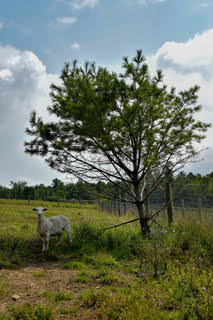‘When we are uncomfortable, they feel the same’: How heat waves affect farm animals
HILLTOWNS — During last week’s heat wave, temperatures in New York climbed above 90 degrees Fahrenheit. Extreme temperatures are more than just uncomfortable for people; they affect behavior. More time spent in air-conditioned rooms, extra laps in the pool, difficulty sleeping, irritability, violence.
Heat has wide-ranging effects on humans physically and psychologically. So, too, does it affect animals.
“When we are uncomfortable, they feel the same,” dairy farmer Ken Saddlemire, of Knox, told The Enterprise this week.
As of last year, Saddlemire had 46 milking cows and around 75 cows total. He said that, when it’s too hot and humid (or too cold, for that matter), cows are less productive.
“Instead of milk production, energy is used to regulate body temperature,” Saddlemire said. “... In hot weather, food intake is lowered and water intake increases dramatically. A full-grown cow producing milk will drink upwards of 50 gallons a day. In cold weather, food intake increases and water consumption is 20 to 30 gallons a day.”
A study from the Journal of Dairy Science ran simulations of animal production in the United States under varying degrees of heat stress, and found that, with minimal intervention, heat stress could cause an annual loss of $2.4 billion.
And not only is there less product, the quality of product diminishes in heat, too, according to one study published in the journal Animal Frontiers. For instance, cheese production relies on specific milk compositions, which are altered when an animal is experiencing heat stress, leading to lower cheese yield.
Animals, of course, don’t have the same variety of strategies that privileged humans do to combat high heat. As yet, cows haven’t figured out how to whip their milk into ice cream, chickens can’t fly to drier climates, and sheep are more or less stuck under the warm, Puritan decency of their wool, helpless to transform it into a titillating two-piece.
Instead, domesticated animals have to rely on built-in temperature regulations, and otherwise on their owners. For Saddlemire’s cows, that means ventilation and shade.
“Ventilation inside barns is very important,” Saddlemire said. “During winter months, moisture is present and could lead to respiratory illness so exhaust fans relieve the humidity and help circulate fresh air. In the summer season, I add three large 4-foot fans to move air in and out of the barn.
“Animals kept outside need fresh water and feed,” he continued. “A structure to provide shelter from the sun, rain or snow, and cold winds.”
Sheep farmer Emily Vincent, meanwhile, hoses down her 300 sheep to keep them cool.
“The sheep don’t sweat,” she explained to The Enterprise last week, as the heat wave was passing over. “They mainly pant, so my sheep are in front of fans panting right now, which is not good because they’re still hot. I take hoses out there and I spray them with water, which helps a little bit. Misting systems help. There’s a lot of things that farmers do to reduce the heat.”
When the sheep are outside, they gather in a pasture that has a lot of trees, Vincent said, which help keep the sheep cool through evapotranspiration, or the release of water vapor. Where there are no trees, Vincent has installed canopies.
She also puts minerals in the sheep’s water, to replace lost electrolytes. “A lot of people don’t think about [the nutrition aspect]. They’re like, ‘Oh, it has water,’” Vincent said. “Well, you don’t get salt in grass. They need that supplementation.”
Last week’s heat wave passed over the region shortly after the United Nations’ Intergovernmental Panel on Climate Change released an earth-quaking report that stated, unequivocally, that the world has already gotten 2.7 degrees warmer (Fahrenheit) since the 19th Century, and that we’re on track to warm it another degree or so within 20 years.
One degree past that, and “heat extremes would more often reach critical tolerance thresholds for agriculture and health,” the IPCC states.
Warmer temperatures mean that the low production livestock farmers experience during heat waves will become more common, to say nothing of the more constant discomfort of the animals themselves.
While animals are currently responding to heat stress in short-term ways, some researchers warn that, if the factors contributing to heat stress are not removed, short-term acclimatization will become genetically embedded adaptations over generations, and the quality reduction detailed earlier may become permanent.
Despite this, Saddlemire, who also serves as a Knox councilman, seemed unperturbed.
“As a farmer, you watch weather closely,” he said. “Timing for planting and harvesting crops can be challenging. I’ve always said that I remember wild swings and weather patterns while growing up … We’ve kept journals of our activities over the years. When you look back, we seem to do things at the same time every year. We start plowing, planting, making hay and harvesting, usually within a few days [of when] we did the previous several years.”
Vincent, on the other hand, wants to stay ahead of these inevitable changes to our planet, and mitigate them where she can.
“It’s definitely something that’s coming,” Vincent said, explaining that she’s thought about applying for a grant that would allow her to “look at ways that we as farmers can cool our animals more efficiently.”
“Heat doesn’t do anything good for animals,” she said.



